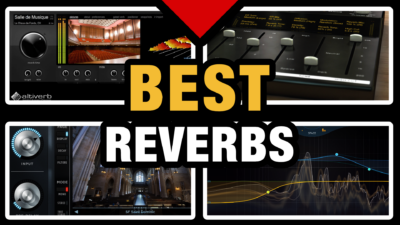 Reverb is one of the most fundamental effects to use in music production, because it shapes the acoustic space, vibe and atmosphere of any track in your mix, and finally your overall ambience of your production.
Reverb is one of the most fundamental effects to use in music production, because it shapes the acoustic space, vibe and atmosphere of any track in your mix, and finally your overall ambience of your production.
I would highly recommend you to invest in one or more high quality and professional Reverb VST Plugins for your music production toolkit. There are of course a lot of products on the market, but this is my top list of recommendations based on both research, audio demos, and personal experience:
10 Best Reverb VST Plugins
- Altiverb
- Spaces 2
- Fabfilter Pro-R
- TSAR-1
- Seventh Heaven
- Blackhole
- Valhalla Shimmer
- Little Plate
- Spring
- Cinematic Rooms
Main Types of Reverb VST Effects
Algorithmic Reverb
The most common reverb effect today in the software world is the algorithmic reverb plugin. This means that the space and all acoustic results of the reverb are calculated mathematically by an algorithm. The advantage is that it is highly customizable, which makes it amazing for sound design. A great algorithmic reverb can be used on any sound, but electronic sounds like synths and sound design elements work especially great.
Convolution Reverb
A convolution reverb plugin is based on an actual recording of an acoustic space, or in some cases a “recording” of the circuit of a hardware reverb. Basically, a convolution reverb plugin will have every preset being a kind of “fingerprint” of a particular space. This makes it amazing for instruments that are heavily influenced by their acoustic space. In my experience this is especially good for orchestral instruments, and any instrument that should sound like a natural recording in a big space.
Plate Reverb
Plate reverbs were used back in the days before electronic reverb effects. They were based on actual big steel plates, hence the name, which reverberated from acoustic energy being fed into them. Plate reverbs are more warm and “mushy” with a lag in the reverb that retains more of the transients of the dry signal. This makes them especially good for sounds in your mix that you want to still have clarity in the transients in. For example: vocals, drums and rhythm guitar.
Spring Reverb
Spring reverbs are similar to plate reverbs, in that they were based on actual material resonating from acoustic energy. In this case, as the name implies, that material were springs. They were common in the 60s, but the most unusual reverb effect today. However, the otherworldly echoey sound of a spring reverb can be excellent for sound design and creating unique spaces for your instruments.
